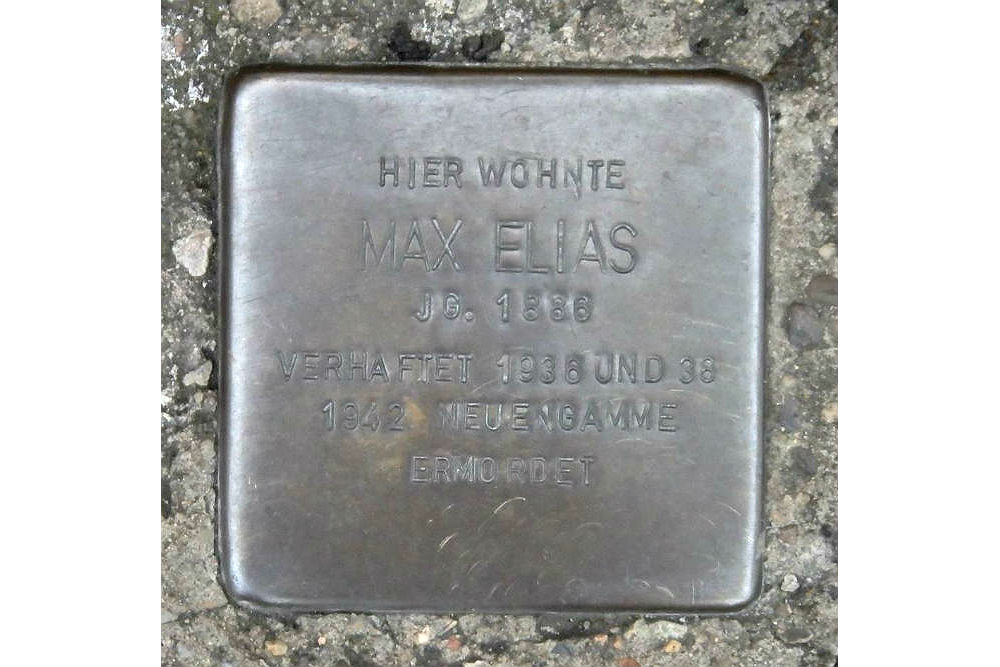Stumbling Stone Normannenweg 7
This small, brass, memorial plaque (Stolperstein or stumbling stone) commemorates:
* Max Elias, born 1886, arrested 1936 and 1938, 1942 Neuengamme, murdered.
Ludwig Gustav Max Elias and his 4 siblings were baptized as evangelicals. In a trial later, Max Elias was judged as having an "unmistakeable Jewish ancestry" (probably from his father’s side of the family). He worked as a representative and a merchant, and he founded several companies in Hamburg. He married twice and had two daughters – Therese and Ursula. But Max Elias’s business ventures did not go well.
In the 1920s he had several convictions for fraud, forgery, and illegal possession of weapons. With his criminal record and Jewish ancestry, he lost all social standing after the rise of the Nazis, and a Nazi judge described his behavior as "typical Jewish business conduct."
The 1930s were worse. In 1933 he was sentenced to 15 months in prison for repeated (relapse) fraud (Rückfallbetrugs), and again in 1936 for 18 months in prison for the same offense. In November 1938 he was sentenced in Hamburg for homosexuality under Section 175 and was sent to the Altona judicial prison for six months. Then he was imprisoned again for fraud in 1939. The length of that sentence is not known.
In November 1942, Max Elias was sent to Neuengamme, where he was used as a bookkeeper. From June to October 1943, he became ill and was admitted to the sick bay. In the autumn of 1944, his name was included on so-called Hollerith cards from the SS Economic Administration Office as part of a 1944 effort to list prisoners from all concentration camps.
When the Nazis emptied the Neuengamme camp in April 1945 before the arrival of the Allies, thousands of prisoners were put on the Cap Arcona, a ship which became an overcrowded concentration camp with no food and no drinking water. The Cap Arcona and several other floating concentration camps were hidden in plain sight among other troop ships. With a goal of keeping the Germans from escaping by ship, the British bombed the ships in the harbor. Approximately 7,000 concentration camp prisoners died by fire or drowning, or were shot by Germans on the shore. It is believed that Max Elias was one of those killed on that day, 3 May 1945.
Four days later, the Germans signed an unconditional surrender of all German forces to the Allies.
"Stolpersteine" is an art project for Europe by Gunter Demnig to commemorate victims of National Socialism (Nazism). Stolpersteine (stumbling stones) are small, 10x10cm brass plaques placed in the pavement in front of the last voluntary residence of (mostly Jewish) victims who were murdered by the Nazis. Each plaque is engraved with the victim’s name, date of birth, and place (mostly a concentration camp) and date of death. By doing this, Gunter Demnig gives an individual memorial to each victim. One stone, one name, one person. He cites the Talmud: "A human being is forgotten only when his or her name is forgotten."
For more information and photos about the Cap Arcona, please see Floating concentration camps in the Bay of Lübeck.
Do you have more information about this location? Inform us!
Source
- Text: Fedor de Vries & Anne Palmer
- Photos: Bernd Carstensen
- Stolpersteine in Hamburg: Max Elias
- Stolpersteine.eu
Nearby
Museum
- Bunkermuseum Hamburg-Hamm - Hamburg-Hamm
- Stadthaus Remembrance Site Hamburg - Hamburg
- School Museum Hamburg - Hamburg-St. Pauli
Point of interest
- Camp Hammerbrook - Hamburg-Hammerbrook
- Air-Raid Shelter Papenstraße - Hamburg-Eilbek
- Air-Raid Shelter Stresowstraße - Hamburg-Rothenburgsort
Monument
- Memorial to Children of Bullenhuser Damm - Hamburg
- Memorial Deportations Hannöverschen Bahnhof - Hamburg
- War Memorial Hamburg-Hamm - Hamburg-Hamm
Cemetery
- Siege Cemetery Hamburg - Hamburg-Barmbek-Süd
- Cemetery for Victims Siege of Hamburg - Hamburg-Altona
- Mausoleum Konrad Daniel von Blücher-Altona - Hamburg-Altona-Altstadt
Remembrance Stone
- Stumbling Stone Normannenweg 23 - Hamburg-Borgfelde
- Stumbling Stone Anckelmannstraße - Hamburg-Borgfelde
- Stumbling Stones Anckelmannstraße 10 - Hamburg-Borgfelde





